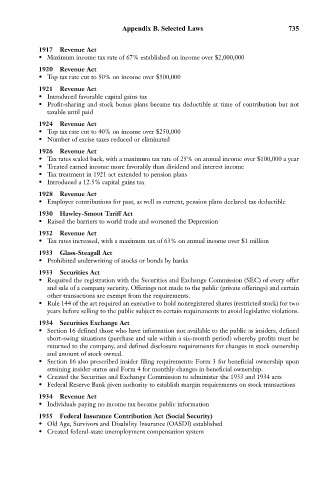Page 750 - Bruce Ellig - The Complete Guide to Executive Compensation (2007)
P. 750
Appendix B. Selected Laws 735
1917 Revenue Act
• Maximum income tax rate of 67% established on income over $2,000,000
1920 Revenue Act
• Top tax rate cut to 50% on income over $500,000
1921 Revenue Act
• Introduced favorable capital gains tax
• Profit-sharing and stock bonus plans became tax deductible at time of contribution but not
taxable until paid
1924 Revenue Act
• Top tax rate cut to 40% on income over $250,000
• Number of excise taxes reduced or eliminated
1926 Revenue Act
• Tax rates scaled back, with a maximum tax rate of 25% on annual income over $100,000 a year
• Treated earned income more favorably than dividend and interest income
• Tax treatment in 1921 act extended to pension plans
• Introduced a 12.5% capital gains tax
1928 Revenue Act
• Employer contributions for past, as well as current, pension plans declared tax deductible
1930 Hawley-Smoot Tariff Act
• Raised the barriers to world trade and worsened the Depression
1932 Revenue Act
• Tax rates increased, with a maximum tax of 63% on annual income over $1 million
1933 Glass-Steagall Act
• Prohibited underwriting of stocks or bonds by banks
1933 Securities Act
• Required the registration with the Securities and Exchange Commission (SEC) of every offer
and sale of a company security. Offerings not made to the public (private offerings) and certain
other transactions are exempt from the requirements.
• Rule 144 of the act required an executive to hold nonregistered shares (restricted stock) for two
years before selling to the public subject to certain requirements to avoid legislative violations.
1934 Securities Exchange Act
• Section 16 defined those who have information not available to the public as insiders, defined
short-swing situations (purchase and sale within a six-month period) whereby profits must be
returned to the company, and defined disclosure requirements for changes in stock ownership
and amount of stock owned.
• Section 16 also prescribed insider filing requirements: Form 3 for beneficial ownership upon
attaining insider status and Form 4 for monthly changes in beneficial ownership.
• Created the Securities and Exchange Commission to administer the 1933 and 1934 acts
• Federal Reserve Bank given authority to establish margin requirements on stock transactions
1934 Revenue Act
• Individuals paying no income tax became public information
1935 Federal Insurance Contribution Act (Social Security)
• Old Age, Survivors and Disability Insurance (OASDI) established
• Created federal-state unemployment compensation system

